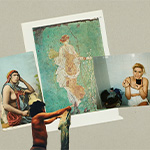The new hanging of the collection exhibition The Way We Are is now being presented for the fifth time at the Weserburg Museum für moderne Kunst. There are many discoveries waiting to be made this time as well, with more than 120 works from 100 artists and artist groups from different times and contexts. Thematic areas extending over 2,500 square meters formulate a multiplicity of different statements from the 1960s to today.
There are spaces devoted to political, contemplative or humanly altered landscapes, to images of Germany, to love in all its clichés, to gender-related or cultural identities, to (post-)colonialism, but also to the concept of painting or to the vertical form. Thus the focus is on art-historical issues as well as on social-political discourses. A basic idea running through the exhibition is the potential of art to develop oppositional points of view onto what is familiar, to adopt surprising perspectives with regard to what links us all, and thereby to offer exciting, unusual, clever, humorous, poetical or merciless foundations for approaching the great issues of our era.
“What began in 2019 as a new orientation and experiment has proven itself in the past four years to be a successful format for the Weserburg Museum für moderne Kunst. Since the introduction of The Way We Are in 2019, we have been able to register a doubling of the number of collections collaborating with our museum. That is not only a wonderful confirmation of the path we have embarked on, but also the assurance of a bright future for the Weserburg as a collectors’ museum.”
Janneke de Vries, Co-Curator of The Way We Are 5.0
What Is There To See?
Birds twitter in the museum elevator. Hollywood clichés of love are examined in succession. Different concepts of painting are presented, or spatial drawings are hung on strings. Enigmatically poetical drawings are made out of posters glued atop each other and then ripped apart, or proverbial sayings turn into three-dimensional objects. The numerous possibilities of the color of black are opened up, or natural landscapes are painted over. Doorknobs and light switches suggest entrances to imaginary worlds, or a parakeet tumbles headfirst into its undoing.
In The Way We Are, young positions hang on a par with old (or older), international positions alongside German artists, including artists from Bremen; art of aborigines or from Africa or the Near East is juxtaposed with works from the Western world.
The thematic areas are complemented by an extraordinary art bar—a former filmset by the American artist Mel Chin and GALA Committee—as well as by an artist space of the British artist Jonathan Monk. The space permanently installed since 2020 in honor of the Bremen painter Norbert Schwontkowski now, on the occasion of the tenth anniversary of his death, brings to light his lamentably less-known graphic oeuvre and combines it with a surprising, artistic proximity to Andreas Slominski.
Living Collection Presentation
The Way We Are is structured as a living collection presentation that is varied at regular intervals. From time to time, art works are added, shift their location or disappear; work constellations are shuffled, thematic areas are reworked and new artist’s spaces are created—in a form that elevates critical inquiry to a principle and delights in transformative discovery. In order to realize this idea even better in the future, the extensive yearly changes that have defined the format up to now will in the future give precedence to smaller or larger alterations that will occur continuously. In this way the collection presentation remains uninterruptedly accessible as such to the public and simultaneously offers constantly new art experiences to individuals who make repeated visits.
The basis for The Way We Are consists of loans from more than thirty international private and corporate collections that have close ties to the Weserburg, as well as complementary loans from artists and galleries along with works from the museum’s own holdings.
Featured Artists
Nevin Aladağ, Francis Alÿs, Tamina Amadyar, Carl Andre, Kader Attia, Hicham Berrada, Julius von Bismarck, Rahel Bruns, Angela Bulloch, Miriam Cahn, Louis Cane, CATPC/Djonga Bismar, CATPC/Irene Kanga, Claudia Christoffel, Claire Fontaine, Mel Chin & GALA Committee, William N. Copley, Paul Czerlitzki, Jeremy Deller, Braco Dimitrijević, Marcel Duchamp, Anna Ehrenstein, Ólafur Elíasson, Jan-Paul Evers, Larissa Fassler, Valérie Favre, Robert Filliou/Daniel Spoerri/André Thomkins, Ceal Floyer, Kasia Fudakowski, Simon Fujiwara, Isa Genzken, Hans Haacke, Terike Haapoja, Raymond Hains, Petrit Halilaj, Mona Hatoum, David Hockney, Sabine Hornig, Nadira Husain, Iran do Espiritu Santo, Mabel Juli (Wiringgoon), Šejla Kamerić, Ellsworth Kelly, Willi Kopf, Kitty Kraus, Alicja Kwade, Zoe Leonard, Ghislaine Leung, Via Lewandowsky, Renzo Martens, Allan McCollum, John McCracken, Tracey Moffat, Jonathan Monk, Horst Müller, Juan Muñoz, Cady Noland, Ruben Ochoa, Ahmet Öğüt, Roman Ondak, Roman Opalka, Paul Pfarr, Claudia Piepenbrock, Charlotte Posenenske, Bettina Pousttchi, Laure Prouvost, Shirley Purdie, Ariel Reichman, Tim Reinecke, Aurora Reinhard, Pipilotti Rist, Fred Sandback, Karin Sander, Norbert Schwontkowski, Ul Seo, Paul Mpagi Sepuya, Richard Serra, Qui Shihua, Santiago Sierra, Marianna Simnett, Andreas Slominski, Daniel Spoerri, Sibylle Springer, Elaine Sturtevant, Mari Sunna, Iiu Susiraja, Walter Swennen, Jean Tinguely, Joëlle Tuerlinckx, Gavin Turk, Anna Uddenberg, Ulay, Kaari Upson, Jorinde Voigt, Franz Erhard Walther, Andy Warhol, Grace Weaver, Claudia Wieser, Cathy Wilkes, Sonja Yakovleva, Nil Yalter, Catherine Yass, Heimo Zobernig
Curated by Ingo Clauß and Janneke de Vries
Press release from Weserburg Museum für moderne Kunst
Image: Kader Attia. Le Corps Reconstruit 9. 2014. Image courtesy of Sammlung Wemhöner



